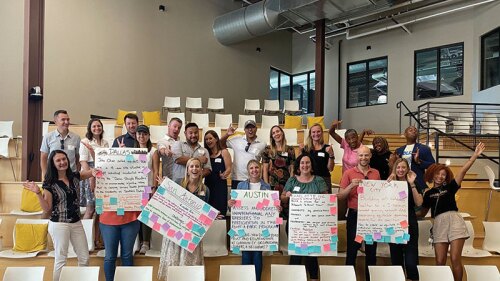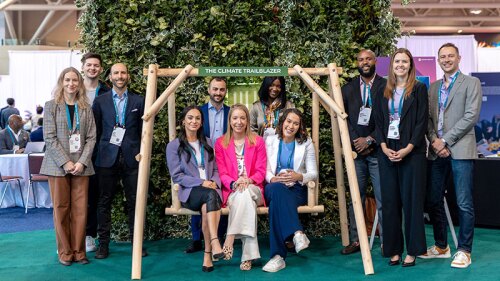By Sarah Funderburk Weston
In sprawling metro areas such as Atlanta, the very notion of a “suburb” is in flux. No longer is the delineation between urban and suburban housing types and community attributes crystal clear as certain types of suburbs are evolving to include higher densities, walkability, and other urban characteristics. This idea was among several discussed at a recent panel and forum held by ULI Atlanta on new suburban paradigms identified in Housing in the Evolving American Suburb, a report produced by the ULI Terwilliger Center for Housing with RCLCO.
Whether in traditionally “suburban” areas or in densifying in-town neighborhoods, Atlanta’s renters and buyers are both looking for increased walkability, amenities, and smarter buildings and that may come in the form of single-family detached homes, mid- to high-rise multifamily development, or perhaps somewhere in the middle, the panel said.
The panelists included Stockton Williams, executive director of the Terwilliger Center; Adam Ducker, managing director, RCLCO; and local developers and experts who are witnessing the changes in suburban development in Atlanta first-hand. The panel asked attendees to look past the typical “city versus suburbs” debate and into the unique challenges and opportunities of the suburbs.
Ducker described a new, housing-focused classification system that RCLCO developed for the Terwilliger report. The system is based on census tract–level data, proximity to a city center, and categories across the urban-suburban spectrum: high-density urban, urban, low-density urban, high-density suburban, suburban, and low-density suburban. Within the three suburban categories, the report puts forth five typologies to categorize suburban development: “established high-end,” “stable middle-income,” “economically challenged,” “greenfield lifestyle,” and “greenfield value.”
In the Atlanta-Sandy Springs-Roswell metropolitan statistical area (MSA), 87 percent of the population lives in areas classified as suburban, with one-quarter living in “greenfield value suburbs.” Under this new framework, traditional Atlanta suburbs, such as Perimeter Center, will likely become classified as urban in the next few years.
Ducker shared a key finding about the Atlanta MSA: Atlanta is a very suburban city, yet it is urbanizing similarly to a 24-hour gateway city and differently than other parts of the Sun Belt.
While the suburbs are still driving employment and population growth in the Atlanta market, the share of population growth and jobs in the urban core has increased significantly. The dominant housing type in suburban developments is still overwhelmingly single-family homes, where residents strive for bigger homes and lots.
Findings revealed that Atlanta’s discrepancy between suburban home values and urban home values was much wider than that in other Sunbelt metro areas, which supports the idea that Atlanta is more like a gateway city where residents are willing to pay a premium to live in or near downtown. Another key finding showed that Atlanta suburbs are more ethnically diverse than the suburbs of the 50 largest metros in general, and particularly those in the Sun Belt. Not only are Atlanta’s suburbs home to a large percentage of minorities, but they are also home to the majority of Atlanta’s millennials.
 New and innovative developments, such as projects along the Atlanta BeltLine and in Midtown, continue to attract residents to Atlanta’s expanding urban core. Close-in neighborhoods are experiencing development and population growth, drawing in newcomers. Despite all the development activity along the urban fringe, suburban areas have also grown increasingly urbanized. Developments such as Avalon and the soon-to-be-opened Battery at SunTrust Park represent strong examples of “drive-to” urbanism. These destinations have elements of urban downtown cores and are densifying with infill residential development.
New and innovative developments, such as projects along the Atlanta BeltLine and in Midtown, continue to attract residents to Atlanta’s expanding urban core. Close-in neighborhoods are experiencing development and population growth, drawing in newcomers. Despite all the development activity along the urban fringe, suburban areas have also grown increasingly urbanized. Developments such as Avalon and the soon-to-be-opened Battery at SunTrust Park represent strong examples of “drive-to” urbanism. These destinations have elements of urban downtown cores and are densifying with infill residential development.
Moving forward, consumers will continue to age and want to buy homes to suit their changing needs. Today’s new products consist of large and single-family or small, urban and multifamily, with few in-between products currently being built.
Ducker spoke of the “missing middle,” where young families are priced out of housing product, empty nesters want to downsize, and low- and middle-income renters cannot afford the products. As homes are being made available, they need to be filled by younger families, many of whom are still renting, which raises the question of how quickly renters will be ready to upgrade into homeowners.
Following the review of the findings from Ducker, panelists discussed zoning changes in Atlanta, the escalating costs of development, rising home prices in both the urban core and the suburbs, and the idea that consumers want similar product types irrespective of the location.
Michael Blair, managing director of development with Pollack Shores, shared that his firm had seen an increase in suburban development and that density has been pushed by public officials and leaders more so than in previous years. “Renting by choice is driving programming for your multifamily developments,” he said. He went on to mention that the same quality of features and amenities were being demanded for both suburban and urban developments.
Said Scott Jones, partner with Site Solutions: “We’re seeing that safety, outdoor space that is programmable, and a focus on activities is what our clients are wanting more and more, no matter where the project is.”
Sarah Funderburk Weston is a ULI Atlanta member and volunteer. She is a partner/director at SPR Atlanta, a public relations firm.




